Take off from the snout
The experience of World War II showed that one of the most vulnerable sides of the frontline aviation are airfields. Even if combat-ready aircraft are preserved in shelters, their use from a destroyed runway becomes impossible. The way to solve the problem was obvious, but the insufficient level of technological development did not allow creating an aircraft that did not need a long runway - the first jet engines, due to their low thrust ratio (the ratio of engine thrust to the mass of the aircraft), had an acceleration of more than a kilometer. But technology did not stand still.
The possibility of creating aircraft with vertical takeoff and landing (VTOL, the English term - VTOL, Vertical Take-Off and Landing) began to be discussed in 1950-s, when the world engine building industry experienced rapid growth. For a vertical take-off, the engine's thrust should have exceeded the weight of the aircraft, but such machines could take off an alarm straight from the hangars or from any unprepared sites. Such a scheme promised exceptional advantages for ship aviation. Projects that recently seemed impossible were actively financed.
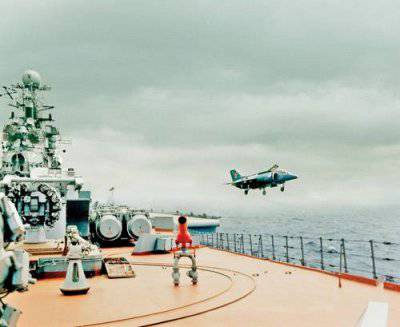 In 1957, Ryan's American X-13 Vertijet made its first flight. This unusual car flew up vertically in every sense. Since the direction of engine thrust had to be changed after taking off the ground in order to start acceleration in the horizontal plane, and in 1950's there was no talk about creating a rotary nozzle, the designers decided to start right from the vertical position. The tiny plane was hanging, catching a nose hook on the projection on a special mast, and when the device started to rise, the system uncoupled.
In 1957, Ryan's American X-13 Vertijet made its first flight. This unusual car flew up vertically in every sense. Since the direction of engine thrust had to be changed after taking off the ground in order to start acceleration in the horizontal plane, and in 1950's there was no talk about creating a rotary nozzle, the designers decided to start right from the vertical position. The tiny plane was hanging, catching a nose hook on the projection on a special mast, and when the device started to rise, the system uncoupled.From the outset, it became clear that the usual way to control the aircraft using aerodynamic surfaces (ailerons, elevators and directions) is completely ineffective at low speeds. The position of the machine “hanging on the engine” can only be done by jet rudders (deflected additional jet micromotors), and the designers, having touched about forty designs, managed to develop such a system. Vertijet successfully flew, and during the demonstration flight even landed near the Pentagon, however, the difficulty in controlling made the plane inaccessible to pilots of average skill, and the program was closed. Numerous projects of other US firms, such as Lockheed and ConVair, also did not reach mass production.
From the “table” to the “moon”
We dealt with this topic on the other side of the ocean - in the USSR and Great Britain. To test and debug new technical solutions, various experimental stands were built, such as the British TMR and its Soviet counterpart, Turbolet. On these vehicles, the turbojet engine was mounted vertically, and the jet rudders were spaced apart on four truss brackets. Because of its appearance, “Turbolet” was called the “flying table”. On the test apparatus fully justified the new concept, showing excellent handling. But if the stand did not require special tactical and technical characteristics, then the combat aircraft should have acceptable qualities and with normal, horizontal flight. For this, it was necessary to develop a new, “lift-marching” engine (PMD), a change in the thrust vector of which was achieved through the use of a rotating nozzle that deflected the jet in the right direction. The first such engine was the English Rolls-Royce Pegasus turbofan.
The design by Rolls-Royce of the new engine proceeded simultaneously with the development of a new aircraft, which Hawker undertook. Sir Sydney Camme himself took part in the creation of the car - one of the famous British engineers, the designer of the famous Hurricane aircraft, which formed the basis of the Royal Air Force fighter aircraft during the “Battle of Britain”. NATO was very interested in the new project and agreed to finance the development, so that in the autumn of 1960, the first experimental machine was rolled out of the Hawker plant workshop. First, the R.1127 Kestrel (as the plane was soon named) made a cycle of test takeoffs "on a leash" (it was attached to the ground with steel cables). It was necessary to accurately determine the characteristics of the power plant and to study the characteristics of the aerodynamics of the aircraft. Finally, after careful processing of the information received and making the necessary changes, test pilot Bill Bradford raised the car into the air for real. Launching and testing Kestrel went at a very fast pace, and a year later Bradford successfully made the first landing on the aircraft carrier Arc Royal. Meanwhile, the designers of Rolls-Royce significantly improved the performance of their engine, and the almost completely redesigned P.1127 went into a series called Harrier Gr.1 (harrier means “swamp harrier”). The first squadron of 12 vehicles was completed in the 1969 year. Her main task was to develop tactics for the use of an unusual aircraft.
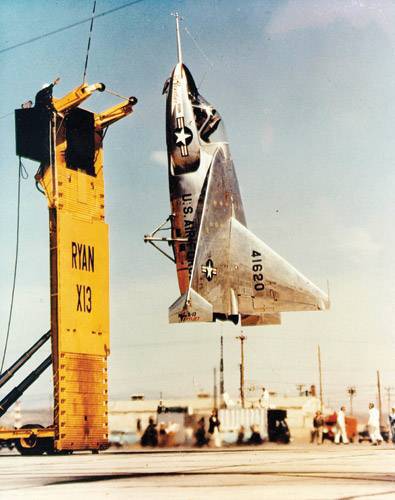 Veridzhet
VeridzhetThe accuracy of the approach to the starting mast necessary for a successful X-13 landing was of the order of 20 cm, which not every pilot could do. When landing, the pilot had to navigate by special marks on the starting mast, and rely on commands from the ground.
Anatomy of "Moon"
The main features of the Harrier design are in its power plant and aircraft control system. The Pegasus (Pegasus) engine has four jet nozzles arranged in pairs on the sides of the aircraft and capable of simultaneously turning to 89,5 ° using a special chain transmission. Thus, with a vertical take-off, lifting force is applied at four points, which gives the aircraft additional stability. The front two nozzles are connected to a low pressure turbocharger, and the rear ones are connected to the engine's combustion chamber. Due to the fact that the engine on the plane is only one, the distribution of thrust to the four nozzles is greatly facilitated, since there is no need for precise coordination of the work of several engines. By changing the position of the nozzles along its axis, the aircraft can produce vertical takeoff and landing, horizontal flight, and even fly “tail forward”.
Traction PMD is so great that when the Pegasus nozzles are lowered down, the pilot is almost unable to control the aircraft’s steady position. In such dangerous modes, an automatic reactive control system is activated. It consists of micromotors installed in the nose and tail parts, as well as on the wing consoles. There are no combustion chambers in these engines, but they work by ejecting compressed air, which is supplied to them through special pipelines from the main engine compressor. The reactive control system allows the Harrier to turn in place in a hover mode in any direction and be controlled by roll. Due to the layout of the aircraft, the “bicycle” chassis scheme is used. It consists of two main pillars, located along the axis of the aircraft, and two supporting, mounted on the ends of the wing.
The total capacity of the internal fuel tanks of the aircraft is 2861 l, it is also possible to suspend two discharged additional tanks for 455 l. A large amount of fuel is necessary because of the huge consumption during vertical take-off and landing, therefore, to improve efficiency, a mode of “shortened” take-off is used, during which during a short run-up part of the lifting force is created by the wing and part by the engine. This decision has significantly increased the range of the aircraft, and because of its very characteristic flight style Harrier received the nickname Jump Jet - “jet skip”. In case of an accident, the aircraft is equipped with one of the most reliable ejection seats - Martin-Baker Mk.9. The takeoff occurs as follows: turning the nozzles to a horizontal position and putting the plane on the brake, the pilot takes the engine to maximum speed, by moving the special handle lowers the nozzles down, and the jet stream takes Harrier off the ground.
During the fighting for the Falkland Islands, the Harrier aircraft demonstrated high efficiency and proved to be dangerous opponents even for such serious opponents as the French Mirage III fighters in service with Argentina. But most loudly about the qualities of Harrier is the fact that with the advent of this remarkable machine, the United States and other NATO countries for a long time abandoned the development of their own VTOLS.
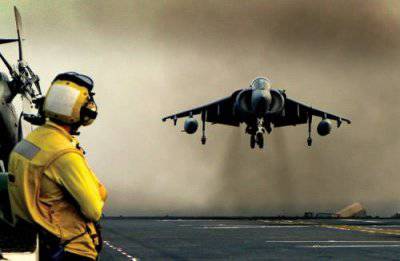 "Harrier" on takeoff. Pay attention to the bulge on the left air intake: it is the fairing of the boom of the refueling system in the air that is currently in the retracted position
"Harrier" on takeoff. Pay attention to the bulge on the left air intake: it is the fairing of the boom of the refueling system in the air that is currently in the retracted positionSoviet experience
In the Soviet Union, many OKBs dealt with the subject of vertical take-off. Most of the experiments were limited to the installation of lifting motors on serial machines. But only the Yakovlev Design Bureau could design a serial VTOL. In the course of work on “vertical lines”, many projects were considered. One unusual suggestion was to use a turbofan engine (on the principle of operation identical to the Pegasus), whose lift fans were to be mounted in the wing, and their rotation was carried out by a gas jet, rather than a mechanical drive. However, Yakovlev understood that the creation of a new engine with a high specific gravity is associated with enormous difficulties, and proposed the creation of an experienced aircraft with a combined propulsion system - a combination of lift-cruise and additional lifting engines. Experiments began with the installation of lift engines on the Yak-28 serial interceptor, and already in 1963, the first Soviet VTOL Yak-36, controlled by Yuri Garnaev, took off.
An unusual machine brought a lot of trouble to both designers and pilots: the new Yak was taught to fly at great cost. Designers led by Stanislav Mordovin had to overcome many hitherto unknown problems associated with the flow of a jet stream around the plane and the nearby surface of the earth. I even had to invent protection to cover a concrete runway that could not withstand the effects of hot gases. A separate problem was the feature of aerodynamics of vertical take-off - the emergence of a rarefied space under the wing, which literally did not allow the car to lift off the ground. A lot of hassle and working out the system of jet rudders, on the principle of operation is identical to the one that stood on the "Harrier". Nevertheless, the problems were solved, and soon the Yak-36, managed by Valentin Mukhin, demonstrated its capabilities at an aviation festival in Domodedovo. However, the aircraft had too modest range and a small payload, so the serial production of the combat vehicle was not discussed.
 The layout of the fighter JSF F-35 VTOL
The layout of the fighter JSF F-35 VTOLAttempt is not torture
However, the experience gained soon allowed the creation of the Yak-38, which entered service with naval aviation. Due to the lack of a suitable PMD in the USSR, the Yak-38 was equipped with three engines at once, two of which were installed vertically behind the pilot’s cabin and turned on only during takeoff and landing, and the third — equipped with swiveling nozzles — was lifted and sustained. On the one hand, such a scheme removed the need to create a new PMD, but on the other hand, the two lifting engines turned off during cruising mode became useless ballast and catastrophically “ate up” the characteristics of the aircraft.
The use of three separate engines at once required the creation of a special system designed to coordinate their work and adjust the thrust. The problem was solved without the use of electronics: the device was completely mechanical, which further increased reliability. Because of the big problems with “overweight”, the Yak-38 design is maximally lightened, in some places even to the detriment of the safety margin. This made it impossible to create a modification intended for an ejection start. There were problems with the power unit Yak-38 - in the tropics during the southern campaigns of aircraft carrying cruisers lifting engines simply refused to start. It was necessary to install additional oxygen cylinders to power the engines, which allowed them to develop acceptable traction.
The combat capabilities of the Yak-38 were extremely limited: firstly, to save weight, the radar had to be abandoned, and secondly, the early Yaks could not lift anything into the air except unguided rockets and small-caliber bombs, which made them almost useless in defense - both against sea and against air targets. In case of anything, the aircraft-carrying cruiser would have to completely rely on its own air defense system and the powerful Granit anti-ship missile system.
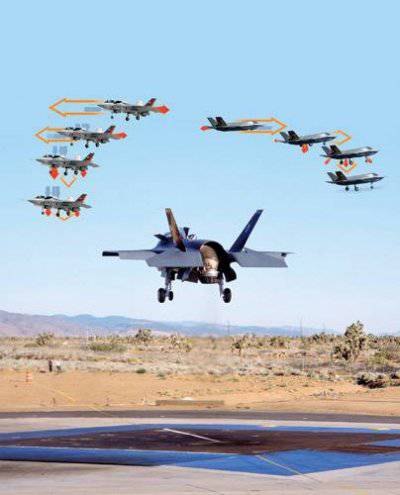 Flight modes F-35
Flight modes F-35"Cucumber"
Despite the very mediocre flight data and the offensive nickname “plane of defense of the mast”, obtained from a very modest range, the Yak-38 allowed engineers and the military to accumulate truly invaluable developments in the operation and use of VTOL. Modification of the Yak-38M already armed with guided missiles and taught to take off with a short run-up (while saving fuel), and a special program was developed for the training of sea pilots, which made it possible to effectively train them on difficult-to-control aircraft. His baptism of fire "cucumber", as the pilots called it, took place in Afghanistan, as part of an air group specially created for this.
During the construction of the Yak-38, a unique in terms of reliability system of automatic forced ejection SK-3М was developed. The fact is that in many cases, when a number of systems fail, during a takeoff, the pilot simply does not have enough reaction time to react to the danger. For example, in the event of a failure of the jet rudder during hovering mode, the plane turns over "on its back" in 1,5 seconds. CK-3M analyzes a variety of parameters, allowing you to detect danger before a person, and issues a signal for automatic ejection of the pilot to the K-36ВМ seat. As a result, although the accident rate of the Yak-38 for the USSR was simply a record, not a single pilot was killed during the entire period of operation of these aircraft with SC-3M turned on. There was a case on the aircraft-carrying cruiser “Minsk” when the crew was catapulted out of the water: engines failed on the Yak-38U (training version), and the plane that fell next to the ship began to sink quickly. The catapult triggered in time threw both pilots out of the cockpit of an already submerged aircraft - the pilots landed on parachutes right onto the cruiser deck. After the collapse of the USSR, all Yak-38 were written off, because the country no longer needed these machines. The last flight of this aircraft took place during the preparation for the demonstration program at the MAKS-95 air show and ended in an accident. Both pilots remained alive.
Created at the end of 1980-ies, the Yak-41 became a direct development of the Yak-38 concept, but with the possibility of supersonic flight. The project was led by the son of Alexander Yakovlev - Sergey Yakovlev. Initially, it was planned to install a single lift-propulsion engine on the plane, but due to the death of Dmitry Ustinov, who patronized the entire program, work on the new power plant was delayed, and soon completely stalled, and the designers had no choice but to decide on the use of a circuit with a combination engines. Despite the viciousness of such a decision that had already become obvious in the experience of the Yak-38, the construction of the aircraft was necessary for the development of all systems and assemblies with the subsequent alteration of the machine for a new, powerful and economical turbofan engine. The upgraded version of the Yak-41M began 9 March 1987, and with the passage of each test phase it became more and more obvious that the plane was quite successful. The fact that the pilot Andrey Sinitsin set 12 world records for climb and flight altitude for the VTOL aircraft speaks about its uniqueness. With the collapse of the Soviet Union, the progress of work on the car, which received the new name - Yak-141, slowed down, and the accident that occurred in 1991 in the year served only as a reason to curtail the project.
 Europe
Europe France, which began developing its own machines at the beginning of the 1960-s, achieved some success in designing the VTOL. The first of these was the Mirage-Balzac fighter, equipped in addition to the Orpheus 803F main engine already with eight lifting! Aircraft tests in the 1964 year ended in disaster. The next aircraft, Mirage V, repeating the design of the predecessor, became the world's first supersonic VTOL. However, he suffered an accident, and work was stopped in favor of the traditional aircraft with the usual take-off and landing.
At the end of 1960-s, several VTOL designs were developed in Germany: the first was the Dornier Do.31 tactical transport aircraft. Despite successful trials, work on Do.31 was discontinued ... due to competition with transport helicopters, which eventually turned out to be more convenient to use. Another unusual development of German engineers is the EWR-Sud VJ-101 supersonic interceptor fighter, whose main propulsion engines were located in two rotary nacelles at the wing tips (and additional lift engines in the fuselage). According to calculations, the system of rotation of the entire engine should have given a certain gain in weight compared with a change in the thrust vector due to the rotary nozzle. The jet control of this aircraft worked by controlling the thrust of the power plant itself. Thus, in hover mode, the plane was balanced on three engines. Despite the beauty of the design and the good performance obtained during the flight, the VJ-101 was never launched in the series. The work of the German concern VFW-Fokker on the VAK-191 fighter with the Pegasus engine was also unsuccessful: the characteristics of the Harrier delivered to the stream turned out to be higher, and it was simply inappropriate to “bring” the new car.
Further perspectives
Despite the widespread use of US Navy Harrier aircraft, the development of VTOL aircraft in this country did not stop. According to some reports, in the mid-1990s between the OKB im. A.S. Yakovlev and Lockheed Martin signed an agreement on joint work under the JAST program to create a promising fighter for the US Air Force (later renamed JSF). In accordance with this agreement, the OKB im. A.S. Yakovleva presented to the American side information and research results on VTOL aircraft, as well as draft designs of the future Yak-201 fighter. This data was used to create the JSF F-35 Lightning II, the most modern development in this direction. Today this aircraft is in flight tests. The new multifunctional fighter will have to replace a number of combat aircraft, including the obsolete Harrier, despite the continuous and effective modernization. The F-35's power plant uses the F-119-PW100 turbofan engine, which was developed by Pratt & Whitney specifically for the F-35. A distinctive feature of the new VTOL aircraft is the use of an external fan installed vertically in the fuselage. The torque is transmitted to the counter-rotating impellers from the turbine through the shaft.
Many modern military analysts are quite skeptical about the F-35 in the VTOL variant, partly believing that using an external fan (which is disabled in flight) is not the best solution in terms of weight savings and that Lockheed Martin repeated in many respects the errors of the Yakovlev design bureau. Nevertheless, the development of aircraft with a short (or vertical) take-off and vertical landing is today one of the most promising and relevant areas. After all, thanks to the use of reconnaissance satellites and high-precision weapons such a structure, as a military airfield, is gradually becoming a thing of the past, giving way to mobile VTOLT, capable of taking off on a mission from any patch.
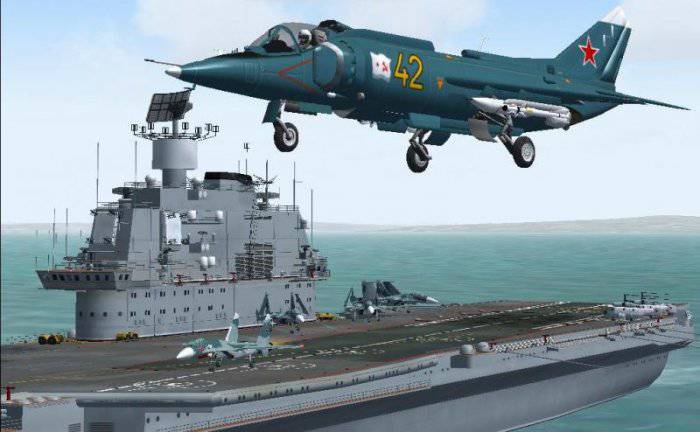
Information